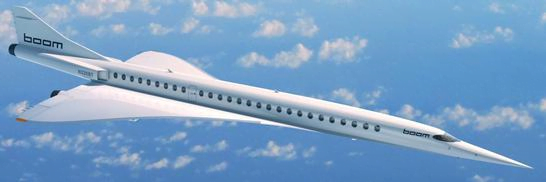UPSC Articles
SCIENCE & TECH/ ECONOMY
Topic:
- GS-3: Science and Technology- developments and their applications and effects in everyday life.
- GS-3: Awareness in the fields of IT, Space, Computers etc.
Supersonic Flying
Context: Nearly two decades since the last supersonic passenger flight, of the British-French airliner Concorde, took off, the planes are set to return to the runways by 2029.
United Airlines of USA has recently announced it was ordering 15 planes (named Overture) with the ability to travel at Mach 1.7, faster than the speed of sound, from the Denver-based startup Boom.
What is a supersonic plane?
- Supersonic aircraft are planes that can fly faster than the speed of sound. Usually, supersonic planes can travel at the speed of around 900 kmph, twice the speed of normal aircraft

- The technology for supersonic flights is actually over 70 years old, but only recently has been used for commercial flying.
- Before 1976, when the first commercial supersonic flight took off, the planes were used entirely for military purposes.
- Concorde, the British-French turbojet-powered commercial airliner, was the first aircraft to carry passengers at supersonic speed, but eventually had to discontinue, due to cost and other concerns.
- Supersonic vehicles in the past have been flagged for their high use of jet fuels, causing extensive environmental damage.
About Boom’s Overture supersonic plane
- Long Range: The Overture aircraft would travel at the speed of Mach 1.7 or 1,805 kmph with a range of 4,250 nautical miles (7871Km). In a single flight, it could carry 65 to 88 passengers and reach an altitude of 60,000 ft. This would enable travel of passengers between busy routes like Paris-New York, Los Angeles to Sydney and San Francisco to Tokyo.
- Halves the Travel Time: Overture aircraft can reduce travel time by about half of today’s planes. Travel time from Singapore to Dubai, usually around seven hours, would be reduced to four hours.
- Commercial Operations within decade: The company has expressed confidence in getting an “experimental” jet ready by 2022, start rolling out aircraft by 2025 and eventually open them for passengers by 2029.
- No Overland Noise: The Overture will also not be noisy as supersonic planes in the past were, Boom claims, as it aims for “zero overland noise.” This essentially means that it will cruise at supersonic speeds only over water, ensuring that no sonic boom or excessive noise reaches the surfaces where people live.
- Coastal buffer zones will be created into route planning of the airline, enabling the Overture planes to travel over Mach 1 only after it reaches a “safe” distance from the shore.
- Net-Zero Emissions: Boom claims to produce an eco-friendly aircraft with “net-zero carbon emissions”, set to fly with 100 per cent sustainable aviation fuel (SAF) made from biodegradable material
- Cost cutting technologies: The company also promises to equip the airliner with advanced aerodynamics and carbon composite materials. Through this, it says, it will be able to cut significant development and maintenance costs in ways which the Concorde planes could not.
- Helps recover the sector impacted by Pandemic: The announcement of the new technology comes at the time when the global aviation industry is bearing losses due to the Covid-19 pandemic, and a third of the world’s air routes have been lost since 2020.
Challenges for Supersonic Overture Flights
- High Production Costs: The costs of making “sustainable” supersonic planes are extremely high. The very nature of its flying — using excessive amounts of fuel and energy — is likely to have high environmental costs.
- Noise Pollution: The very speed of the planes result in producing excessive amounts of noise pollution in the environment. The “Sonic Boom” created by these planes feels like an explosion to the human ear.
- Limitations in areas of operation: Noise pollution caused by Sonic boom limits where and when the supersonic planes can fly. They can only reach their actual speed until they are far enough from people and completely over the ocean.
- Government Approvals: Regulatory approvals to fly such planes can be unsuccessful, especially for transatlantic flights. Getting clearance from regulators around the world would be a challenging task, since the supersonic planes in the past have already been flagged for these hurdles.
- Expensive Fuel: Sustainable aviation fuel is currently very limited in its supply, and is extremely expensive. Moreover, the use of this fuel does not eliminate greenhouse gas emissions altogether.
- Safety Concerns: One of reasons for discontinuance of Concorde flights were safety. The July 2000 accident, when an Air France Concorde crashed right after takeoff, killing all 109 people on board and four on ground, brought safety of supersonic flights into limelight.
- Accessible only to rich: Lastly, it would not be economically feasible for everyone. Only the very rich can afford supersonic planes, as a ticket is likely to be way more costlier than a first class ticket of a regular plane.
Connecting the dots:
- Reforms in India Civil Aviation Sector
- Aviation Flying for all
- UDAN scheme
- National Civil Aviation Policy 2016 and National Civil Aviation programme 2018











